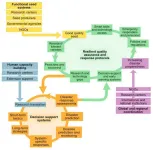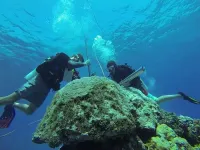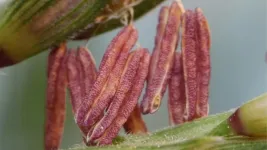Biophysical Society announces the results of its 2024 Elections
2024-08-07
(Press-News.org) ROCKVILLE, MD – Karen Fleming has been elected President-elect of the Biophysical Society (BPS). She will assume the office of President-elect at the 2025 Annual Meeting in Los Angeles, California and begin her term as President during the 2026 Annual Meeting in San Francisco, California.
Fleming is a Professor of Biophysics at Johns Hopkins University. She earned a Bachelor of Arts from the University of Notre Dame before going on to achieve a PhD in Biochemistry and Molecular Biology from Georgetown University Medical Center. In addition to her commitment to research, Fleming has dedicated significant time and energy to serving the greater scientific community through her volunteer leadership efforts.
“The nature and face of science continues to evolve at a rapid pace and as your newly elected future President, I feel a distinct honor and responsibility as I prepare to take the reins and add to this global scientific community we so cherish,” said Fleming. “My plans for my tenure include strengthening the public face of science to allow for educated, informed decisions to be made, to set a plan for navigating new technologies for the betterment of scientific discovery and to ensure our professional organization continues to grow and expand in support of its membership. I look forward to expanding and sharing that vision during my presidency.”
Samantha Harris of the University of Arizona was elected to a second term as Council Treasurer, while four Society members were also elected to serve on Council. They are:
Silvia Cavagnero, University of Wisconsin, Madison, USA
Theanne Griffith, University of California, Davis, USA
Renae Ryan, University of Sydney, Australia
Ryota Iino, Institute for Molecular Science, Japan
Each will serve a three-year term, beginning on February 18, 2025.
###
The Biophysical Society, founded in 1958, is a professional, scientific society established to lead an innovative global community working at the interface of the physical and life sciences, across all levels of complexity, and to foster the dissemination of that knowledge. The Society promotes growth in this expanding field through its Annual Meeting, publications, and outreach activities. Its 6,500 members are located throughout the world, where they teach and conduct research in colleges, universities, laboratories, government agencies, and industry.
END
ELSE PRESS RELEASES FROM THIS DATE:
2024-08-07
Pain management is an important component of caring for adults with cerebral palsy.
However, it's the least understood comorbidity in the adult cerebral palsy population.
A study led by Mark Peterson, Ph.D., M.S., FACSM, a professor of physical medicine and rehabilitation at University of Michigan Health, found that adults living with cerebral palsy had a very high occurrence of pain, with 90% having a pain history and 74% having multiple diagnoses of pain coming from different origins such as the lower back, irritable bowels, joint arthritis and chronic ...
2024-08-07
Scientists at UCL have discovered a novel role played by ribosomes during the folding of new proteins in cells, described in their paper in Nature.
Ribosomes, the cell’s dedicated molecular machines for protein synthesis, make all proteins in life and do so by piecing together one amino acid building block at a time. As they are being synthesised, these nascent proteins simultaneously attempt to fold while still associated to their parent ribosome, referred to as co-translational protein folding.
Understanding how exactly ...
2024-08-07
ITHACA, N.Y. – A new Cornell University study that tracks how many asthma-related emergency room visits result from pollen in metropolitan areas highlights the importance of knowing local plants and the need for developing science-based pollen forecasts.
Such forecasts could alert vulnerable individuals on days when they should consider staying indoors or taking allergy medications ahead of time.
“Even though the percent of asthma-related emergency department visits associated with pollen overall was only a few percent on an annual basis, ...
2024-08-07
An often-overlooked component of natural and human-driven disasters is their potential to affect plant health and thus food security at domestic and international scales. Most disasters have indirect effects on plant health through factors such as disruptions to supply chains and damaged infrastructure, but there is also the potential for direct effects from disasters, such as pathogen or vector dispersal caused by floods, hurricanes, and human migration. These occurrences are rarely isolated and instead often occur simultaneously. We have seen examples of the concurrence of disasters in recent history through events such as market disruptions ...
2024-08-07
Having higher than usual blood sugar levels at the time of hospital admission for an ischemic stroke significantly increases the risk of a poor functional prognosis or death within three months of the stroke. This is the main conclusion of a study by the Endocrinology and Nutrition Services and the Neurology Department of Hospital del Mar, with researchers from the hospital's Research Institute, the RICORS-ICTUS network, and the CIBER of Diabetes and Associated Metabolic Diseases (CIBERDEM). The study ...
2024-08-07
LOS ANGELES — USC Norris Comprehensive Cancer Center, part of Keck Medicine of USC, will open a Newport Beach location offering the latest advancements in radiation therapy and diagnostic imaging. The treatment center, which will open in early 2025, will feature cutting-edge cancer technologies that are yet to be available in Orange County, providing new therapeutic options and optimizing patient outcomes.
The new location address is 4590 MacArthur Blvd. in Newport Beach, less than 15 minutes away from USC Norris’ oncology centers in Newport Beach and Irvine. Those centers are staffed by respected oncologists who have served Orange County for decades, ...
2024-08-07
HOUSTON ― The University of Texas MD Anderson Cancer Center’s Research Highlights showcases the latest breakthroughs in cancer care, research and prevention. These advances are made possible through seamless collaboration between MD Anderson’s world-leading clinicians and scientists, bringing discoveries from the lab to the clinic and back.
Recent developments at MD Anderson include insights into evolutionary cellular adaptations to environmental stressors, potential targets to overcome trouble swallowing in head and neck cancer patients treated with radiation therapy, a promising chemotherapy-free ...
2024-08-07
DURHAM, N.C. – In what appears to be an effort to bypass public health regulations covering vaping products, some tobacco companies have begun replacing nicotine in e-cigarettes with related chemicals that have similar properties but unknown health effects, Duke Health researchers report.
In a research letter appearing Aug. 7 in JAMA, study authors at Duke and Yale University also found that the quantity of these chemicals, known as nicotine analogs, are not accurately disclosed on the packaging.
“Vaping products containing nicotine are subject to federal laws that prohibit sales to people under the age of 21,” said study co-author Sairam V. Jabba, ...
2024-08-07
The Great Barrier Reef is under critical pressure, with warming sea temperatures and mass coral bleaching events threatening to destroy the remarkable ecology, biodiversity, and beauty of the world’s largest coral reef, according to new research published today.
‘Highest ocean heat in four centuries places Great Barrier Reef in danger’, published in Nature (8 August), led by University of Wollongong (UOW) Honorary Fellow and University of Melbourne Lecturer Dr Benjamin Henley, provides new evidence of the impact that rising sea surface temperatures ...
2024-08-07
Cold Spring Harbor Laboratory (CSHL) has begun to unravel a mystery millennia in the making. Our story begins 9,000 years ago. It was then that maize was first domesticated in the Mexican lowlands. Some 5,000 years later, the crop crossed with a species from the Mexican highlands called teosinte mexicana. This resulted in cold adaptability. From here, corn spread across the continent, giving rise to the vegetable that is now such a big part of our diets. But how did it adapt so quickly? What biological mechanisms allowed the highland crop’s traits to take hold? Today, a potential answer emerges.
CSHL Professor and HHMI Investigator Rob Martienssen had ...
LAST 30 PRESS RELEASES:
[Press-News.org] Biophysical Society announces the results of its 2024 Elections


